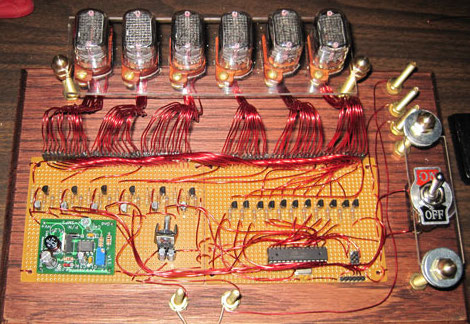
[Tim Anderson] whipped up this nixie tube display using epoxy-coated wires. He’s certainly giving the wire-wrapped LED display a run for its money. He ground the epoxy off the end of each wire using a Dremel before soldering them. We thought you could solder right through the epoxy but maybe not. Was this easier than wire wrapping would have been? We’d bet that because of the voltages wire wrapping wasn’t an option here. That board on the left is the 180V power supply for the tubes with an AVR chip running the Arduino bootloader to the right. After the break there’s a brief demo of data being pulled down over a serial connection. [Tim] also has some plans to add an atomic clock module to this setup sometime down the road.














sure does look purdy
I think by epoxy he means polyurethane enamel.
so sexy
and the video?
Wire wrapping would have worked; in fact, the government-surplus…things I bought to strip for the Nixies and power supplies were mostly wire-wrapped. The power supply board and the BCD decoder/display board were etched circuit boards, but everything else was wire-wrap, including some of the +170V supply to the decoder/display board.
Wave a small flame under the end of the wire, and the enamel will briefly burn and char.
The charred material can then easily be picked off with fingernails.
Melt a small ball of solder at the end of an iron and stab the enamel wire (magnet wire) into it. Melts the enamel every time. I use magnet wire to make micro circuit level repairs almost on a daily basis.
Thanks for the enamel removal advice everyone. I shall try your methods when I build a matching clock module for this display.
Now that’s an awesome nixie project!
As for the enamel wire/soldering iron trick, this only works for wires with coatings that have a low melting point. I’ve tried doing the same trick before with some other random wire and no matter what I did the coating didn’t melt. Had to scrape it off in the end.
The “old fashioned” method for wire prep before soldering often was to dip wire/component ends in a “Solder Pot” which left the dipped lead area cleaned&tinned in one step.
See- working with a several pound dip well of molten lead at our benches used to be considered unremarkable=no special exhausts or splash shields etc. The neatest dip well hack I ever saw was a modified automatic basket dip commercial fryer used to batch dip toroid wound inverter transformer leads.
@Oren Beck
My previous employer used solder pots in the production line. We would use them after hours when working in the APD lab, and I must say, they work pretty damn good!!
Mmmm… I’d forgotten how much I loved those candy-apple red epoxy coated wires. Gotta get me some.
Henry Mu
It’s a beauty eh
Me Likee!
Looks great! My projects usually are wirey, but never in a good way. :-)
/me wonders what’s wrong with “wiring” stuff up..
Personally, I like the wire with clear enamel – it looks like, ‘oh no, the wires are going to short!!’
I’m sorry, but Mike, every time I read one of your posts that says something about “we”, I lose a little more faith in HAD. Who is “we”? Do you mean you, and your surprisingly small knowledge about electronics? You mentioned something about saving time with wire wrapping in the previous article. What? And of course wire wrapping could handle the voltages, wire wrapping (if you do it right) has tons of contact area and is plenty for high-voltage. In fact, this type of stuff used to be mostly wire-wrap. Non issue, especially if there’s no high current. If this comment gets moderated, whoever moderates it, please inform Mike Szczys he’s an idiot.
Normal enamel coatings can’t be burned of with anything less than a flame, and that isn’t good for the copper wire. “Solder-rite” will melt in a solder pot and similar plastic coatings can be soldered-through and are marginally better for voltage withstand and handling, but also more fragile to an accidental touch with the side of the iron during construction. The fumes when it melts/bruns off the end of the iron aren’t too good either.
I’ve migrated to prototyping by soldering actual wire-wrap wire and find it gives more robust results than Solderite-type insulaton.
@cantido
There ain’t nuthin’ wrong with just wiring stuff up. If you are only ever going to make one (or two) of something then doing a printed circuit is a waste of time. If three or more will ever be built then a PCB is the only idea.
Magnetic motor is the best solution our days. Diy magnetic motor proves that is is a real and nice opportunity to build generator fast and easy at home. Magnet times are close already.
If you never heard of it please take a look today.